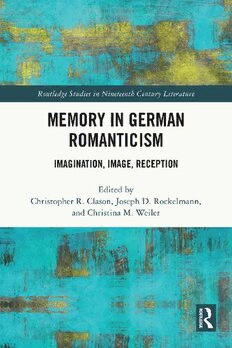
Memory in German Romanticism: Imagination, Image, Reception PDF
276 Pages·2023·2.663 MB·English
Most books are stored in the elastic cloud where traffic is expensive. For this reason, we have a limit on daily download.
Preview Memory in German Romanticism: Imagination, Image, Reception
Description:
Memory in German Romanticism treats memory as a core element in the production and reception of German art and literature of the Romantic era. The contributors explore the artistic expression of memory under the categories of imagination, image, and reception. Romantic literary aesthetics raises the subjective imagination to a level of primary importance for the creation of art. It goes beyond challenging reason and objectivity, two leading intellectual faculties of eighteenth-century Enlightenment, and instead elevates subjective invention to form and sustain memory and imagination. Indeed, memory and imagination, both cognitive functions, seek to assemble the elements of one’s own experience, either directed toward the past (memory) or toward the future (imagination), coherently into a narrative. And like memories, images hold the potential to elicit charged emotional responses; those responses live on through time, becoming part of the spatial and temporal reception of the artist and their work. While imagination generates and images trigger and capture memories, reception creates a temporal-spatial context for art, organizing it and rendering it "memorable," both for good and for bad. Thus, through the categories of imagination, image, and reception, this volume explores the phenomenon of German Romantic memory from different perspectives and in new contexts.
See more
The list of books you might like
Most books are stored in the elastic cloud where traffic is expensive. For this reason, we have a limit on daily download.
